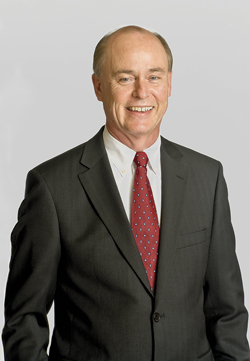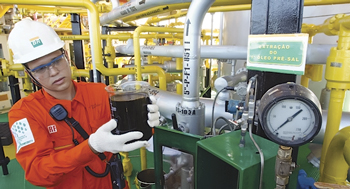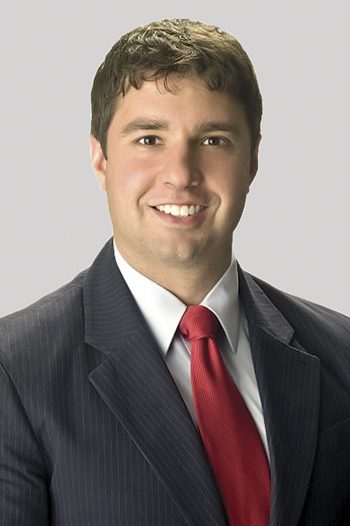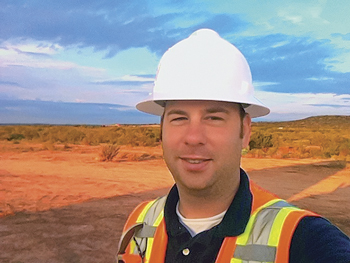RECRUITMENT & RETENTION
Best practices critical for recruiting in a tight job market
World Oil turns the spotlight on a select group of oilfield companies competing for college graduates and seasoned professionals. Two recently recruited employees relate their practical work experiences in diverse sectors of the upstream industry.
NELL LUKOSAVICH, Senior Editor
COMPANY SPOTLIGHT: DAVID NELSON, BHP BILLITON PETROLEUM

While David Nelson, BHP Billiton’s Petroleum vice president of Human Resources, considers the oil and gas market “hot” right now and sees the impact that the shale gas boom has had on recruiting, he believes that there continues to be a consolidation of oil and gas company operations in the Houston area, that puts further strain on the supply/demand curve.
Nelson finds that professionals in any of the subsurface disciplines are just hard to find. “We set our standards high at BHP Billiton Petroleum, and that may be part of our story at the moment, but I think there’s just a general shortage in the industry, and all of our competitors are struggling in these particular disciplines. It runs the whole spectrum, from graduating petroleum engineers to 30-year experienced veterans.”
Tight areas of supply and demand that Nelson sees are in the oil-rich plays of South and West Texas. BHP Billiton Petroleum has over 40 rigs drilling in the Eagle Ford shale and Permian basin, areas where many companies are active. “It’s not just the challenge of finding the local labor to operate our rigs that we’re facing—it really is the boom we saw a few decades ago—accommodation is a major problem. There are some hotels in these parts of Texas that are fully booked three years in advance,” said Nelson.
In Nelson’s experience, recruiting for oil and gas is very specialized, and it is a highly competitive market. “In some ways, there’s a big pool of talent out there, but many companies, us included, have them locked up with retention monies or equity, particularly the very deep technical skills that are in such high demand.”
Once BHP finds qualified candidates, the next step is to test their “fit” with the company culture and technical requirements. The company typically tells candidates that they need two things to excel at BHP: be technically strong at what you do and be a good teammate. “Our global functional organization means that we organize ourselves in a deep, functional way to address some of the most difficult challenges in the industry. From drilling wells in the deepest waters ever drilled, to addressing some breakthrough technology issues in our new onshore plays, we pull people together from different disciplines to solve these problems and they need to excel at collaborating, if our organizational model is going to work,” said Nelson.
Some of BHP’s main areas of focus for recruitment are drilling, geosciences, subsurface engineering and surface engineering. The company is also looking for highly qualified candidates in the HSE discipline, and operations/construction employees for its field operations in West and South Texas. While the company has a heavy focus at the moment on the U.S., it is also looking to recruit new opportunities in other regions, as BHP enters new countries.
BHP Billiton has found LinkedIn to be the most advantageous, reliable social media platform from a recruitment standpoint. “We will continue to look at other social media opportunities over time through pilots and other means. Interestingly, we have found that employee referral is by far the most effective way to bring in new employees to the company,” said Nelson. “We now have close to 40% of our new employees coming in via this route, and are currently running a campaign to make that closer to 50%. We find we get our best-quality employees this way, as employees typically refer good employees, and their loyalty over time seems to be far more substantial than the other vehicles we use. We pay employees $5,000 for every successful referral, and that’s a lot more cost-effective than hiring through recruiting agencies. Interestingly, this month, we are raising the referral fee to $10,000 for some of the key subsurface disciplines.”
Nelson believes that the key to the successful recruitment of graduates, young professionals and executives is an adept, strategic approach. “I would advise students interested in an oil and gas career to begin interning following their sophomore year. This is an opportunity to experience the industry firsthand, while relating classroom theories to real world application. Internships provide exposure to different disciplines within the oil and gas industry, allowing students to discover which areas are of most interest. The majority of engineering and geosciences students hired into our graduate program have engaged in a minimum of one industry internship.” Introduction into the industry at an early age is also important, so that children understand the rich variety of opportunities.
Nelson also suggests that networking with current employees in the industry is key for seasoned professionals. “Networking is a great way for employees to suggest like-minded candidates, and ensures continuity in the culture and quality of candidates company-wide.”
To get the correct message out about opportunities in oil and gas, Nelson believes that the industry needs to do a better job of telling how oil and gas is critical to the modern, industrialized world. “The whole world depends on the products and services we deliver, and the ingenuity and creativity it takes to deliver them! We are high-tech, we are cutting-edge, and we are international in a way and to a degree that few other industries are. A lot of young people today aspire to be involved in those kinds of activities. And we can and should inspire them to join us.”
COMPANY SPOTLIGHT: MAUREEN HOWARD, PETROBRAS AMERICAS

To Maureen Howard, Petrobras Americas’ Human Resources manager, one of the biggest trends in recruiting is the competition among oil and gas companies for experienced engineers. “As the experienced engineers begin to retire, the market for these candidates will become even tighter,” Howard said. “The oil and gas industry is experiencing some exciting times with the advent of new technologies, particularly in deep water. Our candidates will most likely spend their whole lives in this industry, because they love what they do and they can make a good living doing it.”
While Howard sees a vast array of opportunities for both new and seasoned candidates, she sees the candidate pool for experienced workers in this area shrinking, due to boomers retiring, which is the greatest challenge the industry faces. “Since all of us in the industry are looking for the same candidates with a similar skill set, I believe it will come down to the types of projects that a particular oil and gas company is working on. If the projects are new and exciting, using cutting edge technology, then offering the candidate a challenging career will give that company a leg up on the competition,” Howard said. She feels that candidates are pretty savvy in today’s world and understand the roles they are applying for, as well as what the market is paying.
Petrobras America is currently looking for various types of oil and gas engineers. “As far as future focus, it‘s hard to say, you always watch the IT and accounting markets. These markets have had a history of becoming hot, and candidates hard to find,” Howard said. “We offer a very competitive benefits package that, we feel, sets us apart in the market. We are constantly adjusting our retention approach to stay up with the market.”
For experienced professionals, Howard encourages candidates to come with an open mind and be flexible while trying to transition into a new field. The company encourages students to take internships in the field, as well as learn as much about what they think they’d like to do before making any final decisions. Exposure to the industry at an early age is important as well, including learning about different STEM (science, technology, engineering and math) courses that can take them into exciting careers in a multitude of ways. “We must challenge our young, bright minds to see opportunities and encourage them to reach for them,” Howard suggested.
COMPANY SPOTLIGHT: BRANDON BAYLES, HALLIBURTON

According to Brandon Bayles, director of Global Talent Acquisition for Halliburton, oil and gas recruiting has undergone significant change over the past three years, and these differences will continue throughout 2012 and beyond. “In particular, the focus on unconventionals has dramatically changed the technical capabilities demanded by oil and gas companies worldwide. This shift in focus applies to scientists, engineers and field personnel,” said Bayles. With the fast-moving pace of this trend, Bayles foresees a significant supply gap for technical staff, which he says, is an opportunity to re-engage technically trained staff.
“The oil and gas industry has become very important in the day-to-day life of people, with the focus on energy costs (price of gasoline) and the environment/clean energy. The energy industry is very complex including many disciplines in upstream, midstream and downstream, as well as a focus on technology and research and development. Varied backgrounds are needed from scientists to engineers to staff an extensive support network,” Bayles said. “For example, a drilling engineer can sit physically in Houston and work with a team in offshore West Africa. Very few industries have this hands-on global aspect like the energy industry.”
While the gap in the oil and gas workforce leaves an abundance of opportunities, the industry’s dependence on commodity pricing-based cyclical boom-and-bust periods can create a reputation of lack of commitment to employees in the long-term, Bayles admits. “Being in the middle of a global expansion for the upstream and midstream industries, a big challenge over the next decade is to attract and retain employees to support the global growth,” said Bayles. “Another challenge is bridging the gap between current engineers retiring, and the search for new upcoming talent. In order to compete with high-technology and computer industries, time and investment is needed in vocational schools and university programs, not only for engineers and scientists, but also for the hands-on oilfield workers, who are the lifeblood of the industry.”
There are several recruitment strategies that Halliburton currently employs, including the use of Facebook, which the company sees as a place where people globally are getting connected. Halliburton also continues to develop its college recruiting brand through grants, scholarships, faculty awards and greater on-campus involvement throughout the year. To understand the perceptions and preferences of college students, the company’s University Affairs team, partnered with operations, is involved on campus long before Halliburton actually offers jobs to students. “To retain, we focus on the development of key talent and high potentials, and provide them with challenging opportunities, from job rotation and overseas assignments to formal training,” said Bayles.
If you are looking for a career in oil and gas, Bayles suggests focusing on colleges of engineering, natural sciences or geosciences. “We are looking to fill 90% of our entry-level university hiring needs with students that have a STEM (Science, Technology, Engineering, or Math) background. We need individuals with strong analytical and problem-solving skills to help us meet the complex challenges that lie ahead,” Bayles explained. Bayles also encourages internships in the industry and advises experienced professionals to be flexible, be accessible to recruiters, and build a network.
COMPANY SPOTLIGHT: ELLEN CHIN, WEATHERFORD

Weatherford’s Ellen Chin, director of Talent Management and Executive Compensation, sees a vast array of opportunities in the current recruiting landscape. Chin also sees a shortage of talent that requires Weatherford to follow—and constantly update—a strategic plan to recruit the right people for the right positions.
“Recruiting for oil and gas can be difficult, because there is such a wide range of positions we need to fill. We are still experiencing a huge shortage of talent, especially with engineers. We continue to see a decline in students going into engineering in college, and we’re worried about the impact this will have on our future workforce. Although some view this as a perk, we also have to place employees in many areas of the world, some of which are not the most desirable locations,” Chin said. Another challenge that Chin sees the industry facing is finding candidates with the necessary skill sets, including leaders, who have the potential to develop strong leadership competencies.
To recruit the right candidates, Weatherford has invested in a long-term Recruitment Process Outsource (RPO) to increase the company’s capacity to both data-mine passive candidates and attract active candidates. “We do believe that this has also increased our ability to connect with, and better educate a higher volume of candidates during our recruitment process. In addition, we have very region-specific tactics that our recruitment managers employ, based on their market needs,” Chin said. “For example, military recruitment in the United States has been a strong source of new and highly technical employees.”
Weatherford is also utilizing social media (LinkedIn, Facebook and Twitter) to recruit not only young graduates, but also experienced professionals. “Thus far, it has proven to be a great tool for us to source candidates, globally, as well as to provide a mechanism for candidates to find out more about us,” said Chin. While the company is using social media in its recruiting efforts, it is also experimenting with ways in which to use these tools to reach out to current employees. With the light-speed development of social media, Weatherford is also keeping an eye on new trends and researching how those can effectively be incorporated into its recruiting strategy. Chin is also keeping an eye on the burgeoning area of mobile apps.
Despite reaching potential candidates in their own social media space, Chin believes that more can be done to educate young graduates about the opportunities for advancement and the diverse types of positions that are available within the industry. Some examples may include finance and accounting, supply chains, research and development, and many different product lines and support function roles, both in international and domestic assignments. “Often these roles include international travel and extensive training (technical and leadership), that can accelerate an employee’s succession within the industry and beyond,” said Chin, who believes that it is the responsibility of the industry as a whole to connect with potential recruits about the opportunities and tremendous amounts of growth within the oil and gas business.
As for advice to potential candidates, both students and experienced, Chin says, “Do your research! You should also look for a company that values the same beliefs you do and has a culture in which you would like to work. If you are entering the industry, you should look for a company that makes safety a top priority.”
COMPANY SPOTLIGHT: DOYIN AKINYANJU, SCHLUMBERGER

From the vantage point of Schlumberger’s Global Recruiting manager Doyin Akinyanju, as the demand for energy increases, so does the need for hardworking, fresh talent to meet the engineering and technical challenges of today’s upstream oil and gas business. “Attracting new recruits to take over the jobs that are soon to be vacated by the aging workforce is probably the biggest challenge we face,” Akinyanju said.
While the industry faces a shortage of new talent, there is also a need for talent from leading global organizations for both traditional roles, such as engineering, and in niche areas such as geoscience, management and other commercial and business roles. “Many factors contribute to this challenge. One is the macro environment; for example, economic and political instability, and the crashes in oil prices that plague the industry,” said Akinyanju. “When this happens, the demand for fresh recruits significantly slows down, which, in turn, impacts university resourcing.”
Akinyanju believes that other challenges faced by the industry include the lack of education and national infrastructure in some developing countries where the industry works, resulting in these countries being unable to produce sufficient numbers of employable graduates. There is also the challenge of attracting women to roles in science and engineering where, typically, less than a quarter of engineering graduates are women.
Despite an individual company’s efforts, Akinyanju believes that the traditional image of the oil and gas industry is starting to threaten its ability to attract new recruits.” For example, some candidates see the industry as less than environmentally friendly. We acknowledge that our industry has had environmental impact, but a lot has been done over the past few years to minimize that impact,” she said. “Examples include the development of carbon capture and storage (CCS) to help combat climate change, or the development of self-sealing cement.”
Another challenge that Akinyanju runs across with some candidates is the misconception that oil and gas is a dying industry, and will be replaced soon by renewables. “Technology is ensuring that hydrocarbon resources will be extended, that the amounts recovered will increase, and the challenges that the technology represents will remain as exciting as ever,” she said.
Aside from recruiting programs, Schlumberger focuses on accelerating training and development via its global network of learning centers. Courses range from a few days to 12 weeks in duration. The centers are busy year-round, and hold a variety of concurrent courses. Participants develop multidimensional skillsets that equip them with the necessary tools and knowledge, enabling borderless career opportunities that can scan different areas of the world and different business areas. “We require a high degree of mobility from our employees to ensure the right exposure of technical experts to the right technologies, in the right environment. This exposure helps accelerate the development of proficiency and expertise,” Akinyanju said.
Over the last few years, dual careers in Schlumberger among married couples have progressed from being rare to increasingly commonplace. This presents its own set of challenges. Consequently Schlumberger is a sponsor of the Permits Foundation, an organization that lobbies governments on behalf of industry to help make it easier for spouses to obtain work permits.
Employee Spotlight
PETER CAZAMIAS, FMC TECHNOLOGIES

While the industry encourages students to pursue studies in math and science as preparation for a career in oil and gas, there is a variety of backgrounds that can lead professionals into the industry. Peter J. Cazamias, Installation & Intervention Business Segment Manager, pursued a variety of careers—as well as an intensive trek through graduate school—to find his place in the industry.
With a BA degree in political science from Yale, a JD from the University of Texas School of Law, and a finance degree from at The Wharton School, University of Pennsylvania, Cazamias’ drive for leadership and a team-building role led him into a tour as an officer for the U.S. Marines. He then drove the financial operations for a U.S. pipeline company. “I eventually moved into an operational role, which allowed greater practice of general management and problem-solving. My interest in this position came about after living in China and India with my last company for three years,” Cazamias said. “I desired a move to an industry with better growth potential than the infrastructure/pipeline industry, where I had worked.” A friend recommended Cazamias for his current position at FMC, one that he saw as an opportunity to maintain an international footprint.
In his current position at FMC, Cazamias is responsible for developing the strategy for the company’s installation and intervention business line, improving the profitability, and developing strategy for FMC’s Western Region International (Africa) business. With his legal background, he has also assisted in crafting more commercially-sound contractual templates for the life-of-field agreements with FMC’s customers. “I love the fact that this is probably the one, true global business. I love the different regional approaches to exploration and field development, and how those approaches are influenced as much by cultural factors as they are by geological ones,” Cazamias said. “I also love the consequential nature to this industry. In the end, this is about helping to produce an astoundingly significant good that drives modern human existence as we know it: The clothes we wear, the manner in which we travel, the controlled environments in which we live and work—all are made possible by the oil and gas industry.”
DAVID PAVLICK, GLOBAL GEOPHYSICAL

For David Pavlick, assistant party manager at Global Geophysical, landing in the oil patch has been quite a journey. After receiving an applied BA/BS degree in Communications and Leadership, and a minor in Military Science, Pavlick was commissioned into the U.S. Army as a second lieutenant. Throughout his eight years in the Army, Pavlick gained telecommunications and leadership experience in some of the world’s harshest environments, including Iraq and Korea.
Pavlick enjoyed the fast pace of military operations and, as a native Houstonian, was familiar with several aspects of the oil and gas industry that crossed over with his military background, including his work with wireless nodal systems. “I had some friends that had transitioned into the civilian world that were working in finance and sales, and all kinds of other jobs, and just were not happy. They missed certain aspects of the military, and I knew that working in seismic would fill those voids,” Pavlick said. He joined Global Geophysical in 2010 in managing seismic crews, working first in Poland and then in the Permian basin.
Pavlick currently assists the party manager, in managing all aspects of the seismic crew, including company and customer requirements. His job also requires him to remain current on safety policy and procedures, and ensure that accident reporting, analysis and follow-up are in accordance with company procedures. “I maintain quality assurance/control procedures to improve service quality and define policies regarding production, safety and efficiency within the defined job parameters, and, additionally, maintain the operational costs and revenue within the crew budget,” Pavlick said.
Pavlick’s advice to others looking at entering the oil and gas industry is to “be ready to work hard and be a sponge; absorb everything you possibly can from those around you. Global Geophysical provided me an opportunity to grow professionally within the seismic industry, and I have loved every minute of it.” 
|









